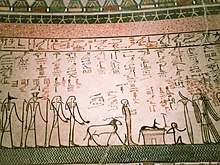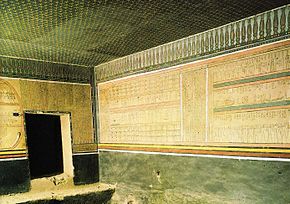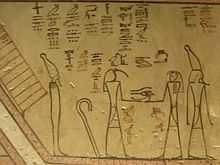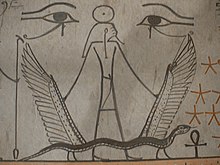Amduat
| Amduat in hieroglyphics | |||||||
|---|---|---|---|---|---|---|---|
Ta medjat imitated Duat T3 mḏ3t jmjt Dw3t The book of what in the Duat is |
|||||||
| 1st and 2nd night hour in the Amduat ( grave of Amenophis II. ) | |||||||
The Amduat (subtitle in short: " The writing of the hidden chamber ") is the oldest ancient Egyptian literary work of the genre of the afterlife . It emerged as a summary under the Amduat title “The book of what is in the Duat ”. The editors of the Amduat used older templates that probably go back to the Old Kingdom . Jan Assmann therefore assigns the theme of the amduat to the sun shrines .
Alexandra von Lieven refers in this connection to the "stick figure drawings" used only in the Amduat, which are very well attested in a similar design for the 6th dynasty and were later replaced by new creations at the beginning of the New Kingdom due to the damaged templates. In addition, in contrast to the other underworld books , the cryptography of the Amduat is based on Memphitic theology . The Amduat also functioned in the New Kingdom as an editorial template for all subsequent underworld books that were based on the contents of the Amduat.
The amduat originally served exclusively for the deceased kings ( pharaohs ) as a guide to the afterlife in their graves. It is therefore mainly documented there at the beginning of the New Kingdom , occasionally in the graves of high-ranking officials . Only later did the amduat find more frequent use in the graves of priests. The scriptures were directed to the "likeness of the sun god Re " and not to the "simple Egyptian".
background

Discoveries in the New Kingdom
The afterlife book “That which is in the Duat” is attested for the first time in grave KV20 of Thutmose I and received in the royal tombs of the New Kingdom as a partially complete representation in short and long versions. The grave KV34 of Thutmose III. (1504 to 1450 BC) in the Valley of the Kings shows an equally complete representation as does the tomb of Amenhotep II ( KV35 ). Only in the grave of Thutmose III. a direct reference of the content to the king becomes clear due to an inscription:
"The book is useful in heaven and on earth for someone who already knows it on earth: Thutmose III, the Blessed , is one who knows it."
In the grave of Seti I ( KV17 ) there are some colored images of the night hours of the Amduat. Further representations were found in the graves of: Hatshepsut , Amenophis III. , Tutankhamun , Eje II. , Ramses II. , Merenptah , Sethos II. , Siptah , Ramses V and Ramses IX. Haremhab and Ramses I refrained from placing the amduat in their graves due to the Amarna period .
content
In twelve sections, which correspond to the twelve hours of the night, the nocturnal journey of the sun god Re through the underworld in a barge is described, in which a total of 908 divine beings are involved, of which 124 named beings participate in the sunset . The distance that Re covers while crossing the Duat is given as almost 39,000 km, which almost corresponds to the actual circumference of the earth . It remains unclear how these distances were determined by the Egyptians and whether a method in connection with land surveying served as the basis, which was considered a great achievement of the Egyptians.
On the night drive, Re encounters various obstacles that he and his helpers overcome. The main enemy is Apophis , who appears in the seventh hour and is subdued by the "Elder Magician", who is probably Seth . The judgment of the dead in the Hall of Complete Truth is not yet the center of the action in the Amduat. The content of the Amduat is not actually a continuous text, but a series of twelve images that show the hour gods for a night hour and are provided with detailed comments.
The amduat also contains extracts from earlier epochs that go back to the time of the pyramid texts . Based on the discoveries, it is scientifically proven and assigned to the New Kingdom, although the time of origin can probably be dated at least to the Middle Kingdom . The Amduat covers the following subject areas:
“To know the beings of the underworld; the secret beings; the gates and ways by which the great God walks; to know what is being done, what is in the hours and their gods; to know the passage of the hours and their gods; to know their transfiguration lines for Re; to know what he is calling out to them; to know the prosperous and the destroyed. "
Hours of the night
| Night hours: names of the goddesses, gates and caves | |||
| hour | Name of the goddess of the hours | Hour gate | Hour cave / hour location |
|---|---|---|---|
| 1 hour | That shatters the foreheads of their enemies | Western gateway of the horizon | |
| 2 hours | The wise one who protects her master | All-devourer | Hall of Complete Truth |
| 3rd hour | The bas cuts | robber | Riverside realms |
| 4th hour | The Great, in the Duat is | Which hides the pulling | With living manifestations |
| 5th hour | Escort end the midst of their bark is | Stopping point of the gods | west |
| 6th hour | Arrival that gives the right (way) | (The) with sharp knives | Waterhole of the underworld |
| 7th hour |
Who fends off the hiu and beheads him with a terrible face |
Gate of Osiris | Mysterious Cave (of Osiris) |
| 8th hour | Mistress of the deep night | That stands without getting tired | Sarcophagus of their gods |
| 9th hour | Worshipers who protect their masters | That the (Nile) flood guards | With bulging figures |
| 10th hour | Angry ones who kill the devious ones |
With great manifestations, giving birth to figures |
With deep waters and high banks |
| 11th hour |
The starry one , mistress of the barque , who fends off the adversary when he emerges |
Resting place of the underworld | Edge of the cave |
| 12th hour | Who sees the perfection of her Lord | That exalts the gods | End of the primeval eclipse |
distribution
In the New Kingdom, the amduat is an integral part of the decoration of a royal tomb and is only rarely used by private individuals. In the third interim period , it is - written on papyrus - also placed in the grave of private individuals. It is attested on sarcophagi until at least the 30th dynasty . While it was mostly written down in full in the 18th dynasty , later only individual hours are usually shown pars per toto .
See also
literature
- Hartwig Altenmüller : B. The afterlife books. 1. The Amduat. In: Handbook of Oriental Studies. First section: The Near and Middle East, ed. by Bertold Spuler . First volume: Egyptology. Section two: literature. Second improved and expanded edition, Brill, Leiden / Cologne 1970, pp. 70–72.
- Erik Hornung : The Amduat: the writing of the hidden space. / ed. based on texts from the graves of the New Reich, Harrassowitz, Wiesbaden 1963–1967.
- Erik Hornung: The Egyptians' underworld books. Artemis, Düsseldorf 1997, ISBN 3-7608-1061-6 .
- Erik Hornung: The night's journey of the sun. New edition, Artemis & Winkler, Düsseldorf / Zurich 1998, ISBN 3-7608-1200-7 .
- Hermann Kees , in: Hans Bonnet : Amduat. In: Lexicon of Egyptian Religious History. Bonn 1952, reprint Nikol, Hamburg 2000, ISBN 3-937872-08-6 , pp. 17-20.
- Alexandra von Lieven : Floor plan of the course of the stars - the so-called groove book. The Carsten Niebuhr Institute of Ancient Eastern Studies (among others), Copenhagen 2007, ISBN 978-87-635-0406-5 .
Web links
- Wallis Budge: The Book of Am-Tuat . (English)
- Scenes of the Amduat in KV34 on Theban Mapping Project (English)
- Digital processing of the Amduat by the artist Jutta Achilles
References and comments
-
↑ In the abridged version of the Amduat there is only the remark “Abriss des Papyrusbuches”. The full subtitle in the long version of the Amduat reads:
“The writing of the hidden chamber. The locations of souls , gods, shadows and transfigured ones . Re's activities for them. The beginning is the horn of the west, the gate of the western horizon, the end is the primeval eclipse . To know the Duat souls, to know what Re is doing for them. To know the secret souls, to know what is in the hours and their gods, to know what he calls out to them. To know the gates and ways in which the Great God walks, to know the course of the hours and their gods, to know the blessed and the destroyed. "
- ↑ Erik Hornung: The Egyptians' underworld books. Artemis, Düsseldorf 1997, p. 18.
- ↑ Alexandra von Lieven: Plan of the course of the stars. Copenhagen 2007, p. 30.
- ↑ Jan Assmann : Stone and Time: Man and Society in Ancient Egypt . Fink, Munich 2003, ISBN 3-7705-2681-3 , p. 63.



